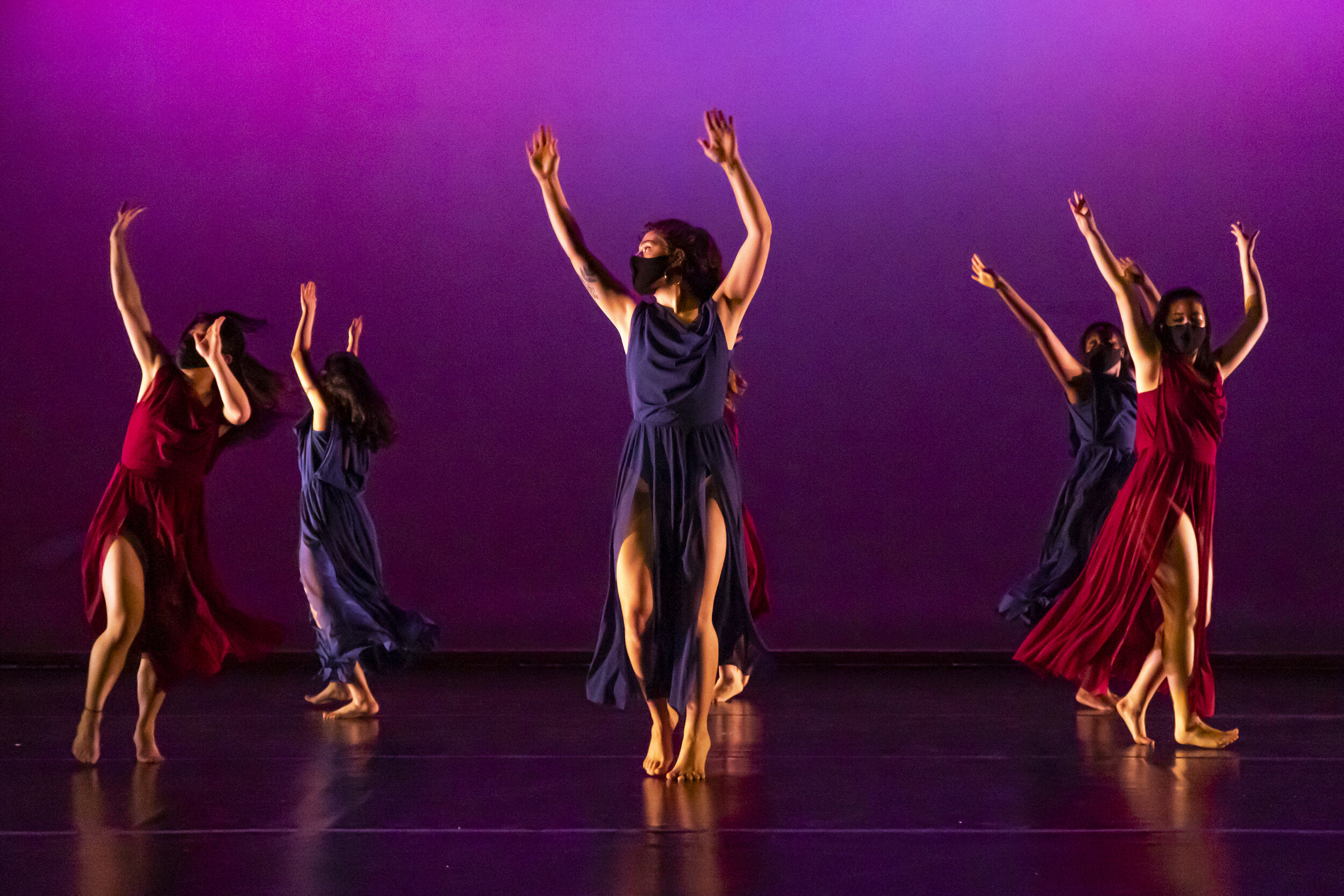In a sea of colored lights, bodies move in sharp yet fluid motion. Dancers enter and exit the stage on invisible command. On Thursday, May 13, the audience at Harbach Theater bore witness to the visions of students in DANC 243 taking form.
Beginning in winter, the class lasts two terms. The first term is mostly spent learning about the work that goes into choreography outside of the physical dance. Students hear from choreographers, costumers and lighting designers to learn all the behind the scenes details that go into a performance. Because the beginning of the course did not have to do with physical movement, there were no real alterations because of the pandemic. This changed, however, when auditions began.
“We had to do that virtually this year which was interesting because it’s hard to really get the sense of a dancer just from watching a small video. You don’t get to see how they learn,” junior Allison LaSalvia said.
Changes due to the pandemic have also affected how difficult the class is. Usually choreographers do not dance in each other’s pieces during this class. However, because there are less available dancers on campus, they now have roles as dancers and choreographers.
“It’s a half credit course in two terms, but it should be worth a lot more because we’re spending about 20 hours a week in the studio choreographing or dancing each other’s pieces. It’s a lot physically. It’s like our rep term, but no one really calls it that. It has been very hectic and there have been a lot of rules we have to work around,” junior Ashley Pineda said.
In addition to the overall shortage of dancers on campus, Pineda had difficulties with casting for her own piece.
“Our dance program doesn’t have a lot of people of color, so it was hard casting. Each time I dance with them, I translate to them what the songs are about. So, mine is mostly about giving voices to those who are not normally heard,” Pineda said.
Pineda’s piece is focused on telling stories of immigration. She uses contemporary and modern dance mixed with Latin dance styles. She says that her personal style is always very mixed, so she utilizes this in her choreography. The movement in the dance is based on the lyrics of the songs and the meaning she is trying to communicate to the audience.
“My piece is called ‘Generations.’ It’s about the different immigrant generations, like second gen, first gen. It’s a three part piece and each part is dedicated to a different generation. I had people answer interview questions and submit their audios and I’m using their audios to tell their stories. I did it because my parents are immigrants. Immigration is something that is really important to me,” Pineda said.
LaSalvia said that most of the students focused on their emotions and backgrounds to decide on topics for their pieces. Her piece also contains mixed dance styles, however, the mix takes on a very different meaning.
“My piece is about how my entire life I have been a jack of all trades, master of none. There have been all of these pieces of myself that I never feel like is good enough. Like maybe I’m not that great at ballet, maybe I should try another style,” LaSalvia said. “But I also don’t want to be defined by one thing. I want to be able to be a chemist, a dancer, a choreographer, a color guard coach, I want to be all of those things. Finding a way for those to each have a place in my life has been difficult.”
Her piece begins with ballet with a soloist accompanied by eight other dancers. Slowly the dancers fall out of ballet and into a modern theme. Then the dancers move back into ballet, questioning which style fits the best. Then there is a second part where there is a soloist who moves from modern dance to ballet. LaSalvia felt it was important to bring in the dancers’ personal experience and interest into the piece, so each dancer’s part has been personalized.
“The third part has a lot of small groups and then it ends with a duet which to me is very symbolic of my experience at Knox because I’m ending with two seniors that I danced with for the first time at Knox. So, the ending, even though no one will know, is that acceptance for me as a dancer and a choreographer and how both of these people represent that in me,” LaSalvia said.
While the planning has continued essentially business as usual, the in-person aspect of the performance and practices have presented challenges because of the pandemic.
“There’s no contact, none of the dancers are allowed to touch each other, which is one of the things I love the most. My favorite part of any dance I’ve ever been in has typically been the moment of contact with other dancers. How do I show tension, distinction, connection without having them touch each other? That has been really interesting, and how to do it without being like ‘this is a substitute for a lift’,” LaSalvia said. “Ballet is very isolating, so that was easy, but one of the things that I love the most about modern dance is the connection that we couldn’t have.”
Although the pandemic restrictions changed a lot of the process and made things more difficult, it also presented some benefits. While there was a small in-person performance for the workshops, the pieces will be recorded and will then be available to be widely shared.
“The beauty of it too is that anyone can see it. My family can see it, who maybe wouldn’t have been able to come and people who wouldn’t have had time,” LaSalvia said.

















